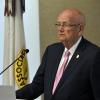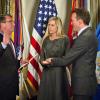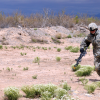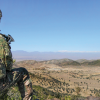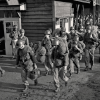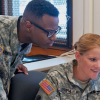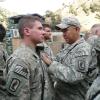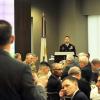Retired Army Lt. Gen. Patricia E. McQuistion will become the Association of the U.S. Army’s vice president for membership and meetings on July 1, succeeding retired Army Lt. Gen. Roger G. Thompson Jr., who will retire on June 30. Thompson, who joined the nonprofit educational association in 2000, and McQuistion, who joined AUSA in November 2015, are both former Army logisticians. Thompson retired from the Army in 1999 after 34 years of service. McQuistion, inducted in May into the Army Ordnance Hall of Fame, joined the AUSA staff in November 2015 after retiring from the Army in April with 35...
Retired Army Gen. Gordon R. Sullivan was honored June 9 during a speech in the House of Representatives as he prepares to step down after more than 18 years as president and CEO of the Association of the U.S. Army.“I rise today on behalf of a grateful nation to thank Gen. Gordon Sullivan and his family for their over five decades of service to our Army,” said Rep. Chris Gibson, R-N.Y. Adding, “His tireless efforts, ensuring our soldiers and their families had the best training and resources and that our veterans returning from combat received the best care, have been unmatched and are a true...
Eric K. Fanning was sworn in May 18 as the 22nd secretary of the Army, 243 days after President Barack Obama nominated him for the position.“It has been a long process to get here, one that I don’t think even the writers from ‘House of Cards’ could have scripted if they tried,” said Fanning, the first openly gay service secretary.Adding, “But it’s worth it. This is a tremendous honor for me – not just the appointment, but the opportunity to be secretary of the greatest Army in the history of the world.”Retired Gen. Gordon R. Sullivan, the Association of the U.S. Army’s president and CEO, said...
The United States Army is a global force—nearly 190,000 Soldiers on active duty in 140 countries. Notably, there are minimal forces forward stationed—only two brigade combat teams (BCTs) stationed in Italy and Germany. For the Army to provide trained and ready forces to the combatant commanders (COCOMs) in a timely and responsive manner, Soldiers and their leaders must have an expeditionary mindset, as the luxury of time is not in their favor. Today’s complex and unpredictable security environment makes it impossible to anticipate when and where the nation will make...
The U.S. Army that has been fighting desert wars for at least 15 years—25 years and has finally created a training course for this arid environment.
The military history of the U.S. Army in the 20th century is an interesting, varied, mostly successful account of some lessons that still provide guidance on how to fight wars. The lessons deserve volumes of research and study but if they exist, I have not seen them. My intent is to identify some of the lessons and present a personal opinion of their influence and relevance.
World War II still provides the first lesson as well as the best example of the effects of military force unreadiness. The result of that oversight in our ability to keep from losing before we could begin winning was...
1 Joint Services Transcript Some soldiers may not know they have an official transcript on file with DoD. This Joint Services Transcript is invaluable. It lists all military education, with a full description of each course. Training, classes and schools attended have been evaluated by the American Council on Education to determine whether a soldier might gain semester-hour credits and at which level classes are categorized: vocational, lower level, upper level or graduate equivalent. When soldiers apply to colleges and universities, DoD will send official electronic transcripts to...
It rained heavily along the 38th Parallel the night of June 25, 1950. That did not trouble the battle-hardened legions of North Korean leader Kim Il Sung that attacked all along the frontier. Kim’s army fielded eight fully manned and well-equipped infantry divisions supported by a tank brigade of more than 100 T-34 tanks.
Five of those divisions were formed around a core of veterans of the Chinese Communist forces that had defeated Chiang Kai-shek’s Nationalist army the previous year. They were well-equipped with robust combat support down to battalion level. The North Koreans had a modest but...
It rained heavily along the 38th Parallel the night of June 25, 1950. That did not trouble the battle-hardened legions of North Korean leader Kim Il Sung that attacked all along the frontier. Kim’s army fielded eight fully manned and well-equipped infantry divisions supported by a tank brigade of more than 100 T-34 tanks.
Five of those divisions were formed around a core of veterans of the Chinese Communist forces that had defeated Chiang Kai-shek’s Nationalist army the previous year. They were well-equipped with robust combat support down to battalion level. The North Koreans had a modest but...
Many of us associate the War of 1812 with the heroic exploits of Andrew Jackson at New Orleans in 1815, and first lady Dolley Madison saving a portrait of George Washington as she fled the White House in 1814. Francis Scott Key’s poem, which 100 years later would become our national anthem, was inspired by the failed attempt of the British fleet to capture Fort McHenry at Baltimore in 1814. Former Presidents Thomas Jefferson and John Adams were still alive to witness the British burn Washington, D.C., to the ground.
A Regular Army of 35,000 augmented by tens of thousands more in militia forces...
I have been fortunate to have served in positions that enabled me to learn from our Army’s senior leaders in a variety of settings. I have had a tactical command in the U.S. Army Military District of Washington and served on an operations staff in the bowels of the Pentagon, and I am presently serving at the pinnacle of strategic education at the U.S. Army War College. These experiences have given me the opportunity to contemplate the spectrum of training and education in the Army’s professional development program.
The Army’s goal is to develop a force that is properly trained and sufficiently...
Reviews of books featuring Mark Bowden essays, Benedict Arnold and Soldier Science.
(This article originally appeared in the Breaking Defense online magazine at www.breakingdefense.com)
These are dangerous times for the U.S. Army, but it would be a tragedy if the increasingly frantic warnings about having a smaller and underfunded force left anyone thinking America’s soldiers are weak or unwilling to fight.
It’s true that an Army of less than 1 million Total Force soldiers (active, reserve, and guard) is too small given the expanding demands for deployed and forward-stationed troops, increasing risks to national security as well as the chance of casualties among our ranks.
It’s...
The returning threat of sequestration if politicians cannot agree on spending priorities represents “a clear and present danger” to the Army’s ability to fulfill its national security obligations, Army Vice Chief of Staff Gen. Daniel B. Allyn said.
Sequestration, the automatic budget cuts that would occur if spending exceeds previously approved budget caps, was suspended for two years by a temporary agreement but will return as a threat in fiscal year 2018.
“For the Army to move forward and address our readiness and modernization shortfalls, the Budget Control Act must be repealed,” Allyn said...
The theme of the Association of the U.S. Army’s 2016 Annual Meeting and Exposition is “America’s Army: Ready Today, Preparing for the Future.”



